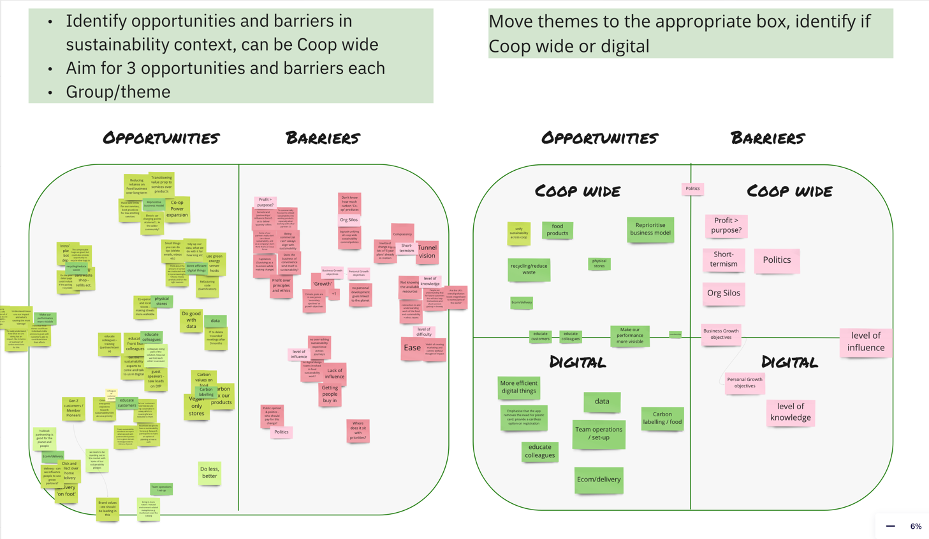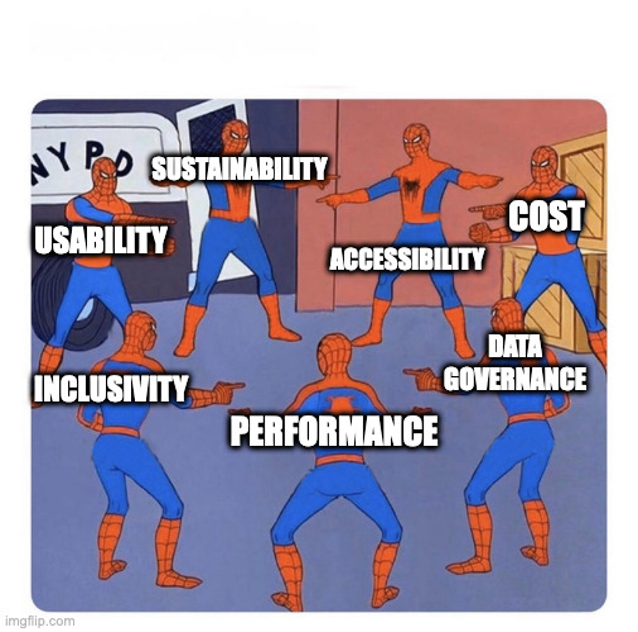Over 18 months ago, we wrote about how we planned to commit to designing more responsibly at Co-op. This is my take on some of the steps we’ve taken so far, in particular how we pulled it together to share with our DT&D leadership team.
Whilst this is my (unofficial) view, the work has been done as part of a informal group of ‘sustainability champions’ kick started by Siobhan. All of this work has been a team effort. Particular shout outs for Marianne, Rachel, Jack and Preetha.
We’ve also had input from people outside of our immediate team, in particualr sustainability specialists like Stephen and Cathryn at Co-op, as well as external experts including Chris, Gerry, and Graeme. Thanks to everyone for their willingness to input and support the work we’re doing.
What we prioritised
Early in conversations we realised that there is a LOT of things we could do as next steps, as well as things that could block us doing them. We spent a fair amount of time just figuring out where to even start.

The process we took (over a number of workshop style sessions) alongside the other experts we brought into the conversations was at times messy and circular. Not least because we had no idea what time we have to commit to this work, it was all ‘side of desk’. So I can’t pretend it was crystal clear at the outset, but reflecting back I think there were three common threads that we explored.
- Creating a written thing to act as a reference point for what we wanted to achieve
- Collecting data that we can use to benchmark our current position
- Creating awareness and increase literacy of digital sustainability at Co-op
This is roughly the story of how we went about these things:
Creating a written thing
We started out on this conversation talking about a ‘strategy’ for digital sustainability. As we talked, we continually returned to our aim of seeing actual change in how teams work, and questioned whether a strategy developed from the bottom up would achieve that? Who will advocate for the strategy and does anyone actually need another strategy?
Whilst we weren’t sure what to call it, the content starting taking shape as we researched other people’s approaches and good examples of e.g. strategies for sustainable web design.
The aspiration was to create something that:
- Could be a point of reference for teams to use, to enable them to start making changes in their own work
- Made our commitment public, so we are more likely to hold ourselves accountable to it
- Acted as a conversation starter with people who have not considered the topic
- Enabled us to collect feedback about what does and doesn’t make sense to teams as they read and try to use it
After reflecting on what had achieved similar outcomes previously, discussion moved to our accessibility policy. It is something that is widely adopted and referenced within Co-op design teams especially. Its a minimum expectation that we will work to it. It is promoted and updated by our accessibility champions and they collectively organise and provide training to improve practice and raise awareness/literacy across the design and engineering team (and beyond!).
We recognised a lot of what we were hoping to achieve and so picked up the format of a ‘policy’ and ran with it. This was primarily led by Marianne, who brought her content design expertise to creating a draft document that made sense and communicated potential opportunities for change. Whilst still a working draft (that isn’t public yet), the policy now covers:
- Why we have a digital sustainability policy
- Things we can do to increase digital sustainability and reduce energy demand
- Ways of working
- Engineering and development practice
- Supply chain
- Hosting
- Equipment
- Data and storage
- What we are already doing
- Responsibility for digital sustainability
- Awareness of the digital sustainability policy
- Help with sustainability
- How we will measure the success of the digital sustainability policy
- Information and resources on digital sustainability
Even just writing that out has clarified to me that we could already update some of the unfinished sections!
Collecting benchmarking data
One thing we identified early on was that we didn’t have a good benchmark for how sustainable our current digital products or technology infrastructure was. To be totally honest, we still dont. That said, we have a better handle on what data we do or don’t have already, and who has access to that data.
The data we were able to collect fell into the following buckets
External facing web products
Co-op has a lot of separate customer and colleague facing websites, between them they average over 28 million hits per month (thanks Marc). The first step I took here was to use Website carbon calculator to get a figures for key pages across different businesses. I combined that with data that Omid had collected into a performance dashboard to bring to life some of the reasons behind why different pages had different scores. There was a very strong correlation between standard performance metrics (page weight and speed) and carbon intensity of each page.
In part this enabled me to tell the story of the close link between sustainability and accessibility, performance, usability and cost etc. Sustainability is not just a moral obligation that works against our other priorities, done well it supports many of the other good practices we aim for.

Internal data storage and file sharing
Looking internally, I knew that the amount of data we created and stored as a company would have a big bearing on our digital footprint. At Co-op this mostly means Office 365. That includes SharePoint, Exchange (emails) and Onedrive. Whilst doing some searching for tools to quantify this I came across Emissions Impact Dashboard for Microsoft 365. A couple of messages later and I had some time with our ‘Domain Principal for Collaboration Services’ – the person who knows everything about our Office 365 usage. Turns out they had already deployed the tool and could share some high level data.
Whilst imperfect, the combination of these two data sets enabled us to make what had previously been abstract conversation into more tangible impact. When you’re talking in tons of carbon dioxide equivalent based on your own data, its harder to ignore.
There are still opportunities to do more with:
- Microsft Azure emissions dashboard
- AWS dashboards
- Open source tools that calculate the your combined cloud footprint
What I increasingly found through these conversations, was that often the people who had access to this data, were also the people who had been involved in work to make this technology more efficient, cheaper or sustainable already E.g. the contact who had deployed the Microsoft Emissions Dashboard, has been involved in decommissioning a large sharepoint site. I also heard other examples of teams already running experiments to reduce their AWS costs and energy usage too. I’m hoping to be able to share more of these examples, but as you can imagine some of it is a bit more commercially sensitive so am getting the all clear before I do so.
Raising awareness
This was probably the one we were least pro-active about. Whilst there’s been a committed small group of people that we’ve tried to galvanise, its not spread much beyond that core team. We have an open slack channel on all things #sustainability and then a closed #sustainability-champions one. We’ve held community of practice style sessions where we’ve either developed and reviewed the policy or invited external speakers.
I’m also very aware that people’s time is already very committed, people have day to day teams and other communities of practice. Even if people wanted to commit time, its not always possible and we shouldn’t prioritise boosting attendance distract from trying to progress things.
What’s next
Sharing this work with our Digital, Technology and Data leadership team generated good conversation, questions and generally showed appetite from them for more, but the real change needs to happen within teams.
We had some feedback around whether a ‘policy’ was the right way to position the document we had created, but overall the response was positive. So we’re hoping to move continue developing it and ultimately publish as some form of ‘guidelines’. Watch this space.
In the mean time the main aim is to actually see change happen, teams taking initiative to reduce the energy consumption of their ways of working and the products they design, build and manage. We suspect this will be partly driven by the policy or guidelines that are sponsored by leadership, but equally (if not more so) through individual’s personal motivation. To boost this we’re planning a session as part of our internal team conference in June, as well as more community of practice sessions lined up to help spread the word.
I’ll also be compiling and sharing resources for people to make use of too in the hope that people are often keen to expereiment with new ways of working anyway.
Another positive that’s come out of this process is that its opened doors to conversations with people thinking about similar topics, I’ve already had invites for relevant conversations that I didn’t even know were happening. Half the work in a place like Co-op is trying to join the dots between what’s already happening.
If you’re exploring similar things within your own organisation, feel free to get in touch on twitter or LinkedIn, I’d be happy to share anything I’ve learned.

Leave a comment